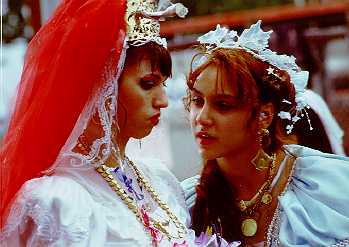
3. Nuptial rites
According to my informants, the nuptial rite of the Khorakhané Shiptari does not differ substantially from that of Albanians peasants or shepherds in Kosovo or Montenegro in any significant way (13). The general ritual structure is shared by other Muslim populations of the Balkans (Silverman 1996: 68), mainly as a result of the prolonged Turkish occupation of this part of Europe. The analysis of a shiptaro nuptial rite, enacted by particularly qualified interpreters such as the Roma, is of considerable interest for the interpretations that the protagonists themselves provide for it. The protagonists are usually highly aware of the meanings attached to the complex symbolic apparatus of this particular rite, as well as others that are performed in their community.

Khorakhané wedding: the bride and a friend. St.Caterina Camp, Bologna - Photo N. Staiti
Nuptial rites take place in two parts and in two different places. The first takes place at the house of the bride's parents, where relatives of the bridegroom go in order to be reassured that she is worthy of the family. Then they take her to the groom's home, where the second half of the ceremony takes place.
The main events of the first part are the weeping of the bride, the dressing and the henna ceremony, the pouring of sweets over the bride's head, the 'Dance of Weeping' or 'Farewell' between father and daughter, the 'Dance of the Virgin Tambourine', and the delivery of the bride to the bridegroom's father. The second part features a display of the gifts, the eating of the bread with sugar and salt, the 'Ceremony of Honey' (or water and sugar), a banquet, the 'Dance of the Bread', the 'Dance of the Apron', the consummation rites and the exhibiting of the sheet with the 'Dance of the Fertilised Tambourine' (14).
After the visit of the groom's relatives, the male neighbours and friends who have convened for the occasion also take their leave. In their place come the women of the household and other women neighbours. One or two of these begin to play the tambourines, and the bride, weeping, her face covered by a handkerchief, and guided by her mother or by an aunt, walks among the other women who sit next to the side walls of the room, and takes leave of them. Then she is invited to sit at the centre of the room, where the rite of weeping properly begins. The weeping of the bride is a ceremony during which the young woman sobs out loud with her head and face covered by the handkerchief, in the presence of the women of the family (who are also visibly moved and who alternate laughter and tears) and of some of the closer male relatives (who, when present, maintain instead an indifferent and relaxed posture). The bride, in a state of semi-consciousness, sometimes close to a trance, weeps for the entire day, accompanied by the song of a woman and by the sound of a tambourine which is played by the woman who sings. The text of the song, in Romani, is, in fact, that of a funeral lament. Through the use of stereotypical formulae interspersed with refrains (also of a formulaic nature), it recalls the virtues of the young woman :
Casual references to the concrete situation of a specific person (most often the name of the bride, or that of her parents, and other relatives) are sometimes added to these stereotypical formulae.
The weeping is regulated by the melody of the song and the sound of the tambourine: often one can observe how, upon the ceasing of the instrument, the girl also stops weeping, only to start again when the rhythm takes up again. At other times, when the sobbing tends to either decrease or to become too convulsive, a woman from the family also begins to cry loudly in the bride's ear, sometimes lifting the handkerchief to make herself heard even better. In addition, she plays a particular rhythm next to the bride's shoulders, in such a way as to make her move with the sound of the instrument.
![]() the
weeping bride (.mov file 384 kb)
the
weeping bride (.mov file 384 kb)
The relationship of these acts to the funeral lament is evident. Ernesto De Martino, the author of a broad study on the funeral lament in southern Italy (and especially in Basilicata; see De Martino 1958, Magrini 1994) discusses characteristics of the funeral lament that are entirely shared by the weeping of the bride discussed here. These include:
According to De Martino, the use of funeral laments for the bride's departure from the parental house had, at the time he was writing, disappeared for some time in Basilicata; however, one could find traces of it "in the Albanian colonies of the Calabro-Lucanian area" (1975: 78). In its early stages, it is likely that this ritual was particularly common in the Albanian colonies, or even exclusive to them, given the importance it assumes in the nuptial rites in areas in which the Albanian language is spoken, and Albanian cultural forms are common.
The weeping of the bride amongst the Khorakhané Shiptari is distinct from the rites studied by De Martino in a number of ways. It is most important to point out here the presence and the active participation of the departing bride, something which is obviously impossible when mourning a dead person. The role of music as a frame for, and a regulator of, grief is here strengthened by the presence of the tambourine, which is absent in the funeral lament, either in the region studied by De Martino or in the areas from which the Khorakhané originate. The tambourine, in the Near and Middle-East and in the whole of the Mediterranean, is linked to the female gods, to female ecstatic rites (see Guizzi and Staiti 1989: 35-36 and Guizzi and Staiti 1992: 64-66), and to sexual inversions practiced in ritual occasions, during which men symbolically transform themselves into women by playing the instrument (see Guizzi and Staiti 1992: 64-66), whose inner parts, i.e., the hollow body and the diaphragm, are perceived as representations of, respectively, a female belly and hymen (15).
In the nuptial rites the tambourine is not only used to accompany the weeping of the bride, but it also becomes identified with her throughout the whole ceremony. On the evening of the weeping, the girl is dressed with a white gown after leaving the imprint of her hands (dyed with henna) on a towel, which will be hung up for a while in the house of the bridegroom. Her white gown, then, replaces the purple or blue one, which she wears for the lamenting. Also, her head is covered with a red veil. Then she is accompanied outside the door of the house: here the bride's last resistance to abandoning her father's house is ritually broken: she grasps the jambs of the door, but is pulled away by her relatives.
![]() the bride at
the door (.mov file 706 kb)
the bride at
the door (.mov file 706 kb)
Then the same relatives, in front of the house, pour a casket of sweets over her head, which the couple will eat in the nuptial bedroom. From the end of the weeping ceremony the bride, her eyes lowered, in strict silence, assumes an attitude of shameful reserve which frequently slides into a state of semi-trance, caused by the long weeping rite. From then on, and throughout all the ceremonies, at more or less regular intervals, she carries out with her hand a tremulous gesture of farewell.
The same gesture will still be repeated for a few months after the wedding as a greeting to all visitors who come to the bridegroom's house. After the shower of sweets a dance take place, which the women of the family initiate; the leader brandishes a ceremonial tambourine. This is an instrument painted red and adorned with flowers and foliage. It is not played, but is used after the consummation of the wedding to carry the sheets stained with blood.
![]() dance (.mov file 607 kb)
dance (.mov file 607 kb)
These are then carried in a danced procession through the village by the women of the bridegroom's family.
Still in front of the house, another dance takes place, in which the bride and her father dance together, crying. The open-air dances are not accompanied by the tambourine, but by a professional all-male orchestra, which today generally consists of electronic keyboard, drums with very taut membranes, saxophone, banjo (jembush), and occasionally also electric guitar and bass guitar. At the end of a day of collective dancing and feasting the procession formed by the relatives of the bridegroom goes bring the bride to his house. As they leave the village they are stopped by the father of the bride who asks his daughter's father- in-law: "where are you going with my daughter?" To which he is answered: "I am taking her as a bride for my son". The bride's father at this point pronounces the words which sanction the completed marriage contract: "Now my daughter is your flesh, although she remains my blood ". This phrase underlines the power of the father to intervene in favour of his daughter when she is not treated with due respect, and even to take her back if he thinks it necessary. It also stresses the acceptance of a patrilineal and patrilocal pact: the daughter becomes 'flesh' of the husband's family, with whom she will live and to whom she will bear sons.

Dancing procession with the cerimonial tambourine - Photo N. Staiti
The nuptial procession, accompanied by the sound of the tambourine, proceeds in the direction of the husband's house, where the second part of the ceremony takes place. The arrival of the bride is welcomed with music and is accompanied by close male relatives of the husband, who brandish a baton decorated with coloured ribbons and a full water bottle decorated with flowers. A tray with bread, salt, and sugar is brought to the front of the house. The men take a piece of bread, dip it in the salt and the sugar, and eat it. At the husband's house, during the first day of festivities, the presents are exposed and carried about in procession, usually to the sound of the tambourine. Afterwards, a large loaf is placed on the head of the bride, which is fought for by the guests and eaten while dancing. Then, the bride dances on a white apron. The jambs of the door of the husband's house are then sprinkled by the bride with honey or with water and sugar. At night, at the end of the feast, the newly-weds retire to the nuptial bedroom to consummate the marriage, while outside the dances become faster and more intense. Afterwards the sheets stained with blood, a sign of the virginity of the bride and of the completed consummation of the marriage, are wrapped in a red cloth, placed inside the ceremonial tambourine and carried by the women of the bridegroom's family in a dancing procession throughout the village.
Forward | Back | Rom main page | References